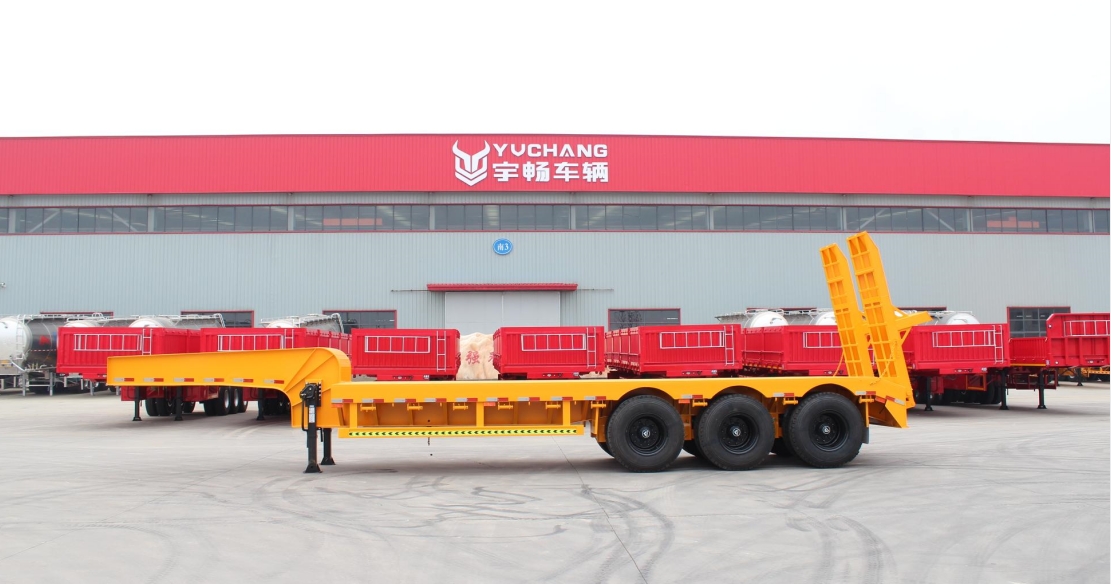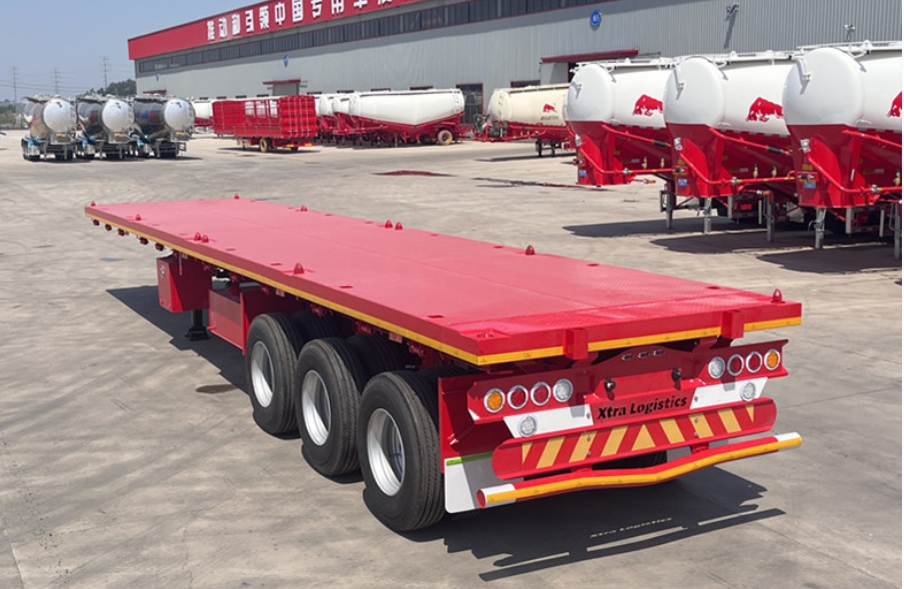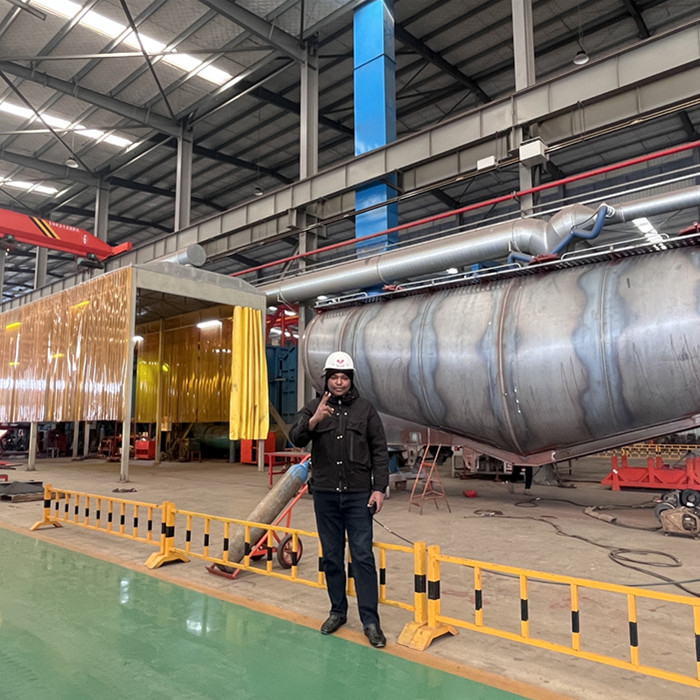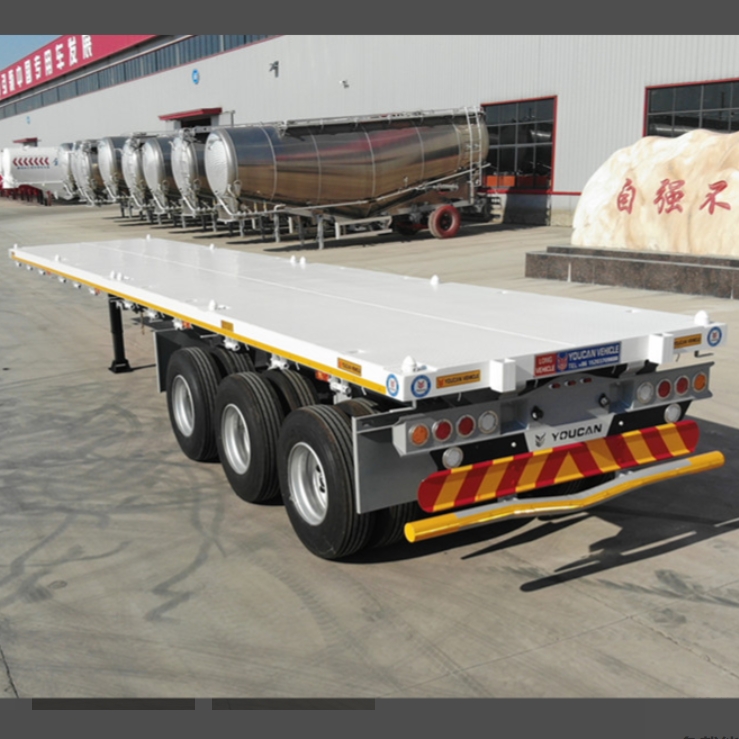Lowbed Trailer vs Flatbed Semi Trailer: A Comprehensive Overview
When it comes to transporting heavy loads and oversized cargo, lowbed trailers and flatbed semi trailers are among the top choices in the transportation industry. In this article, we will explore the definitions, main types, features, history, and applications of these two versatile trailer options. After reading this article,we hope that you are now better equipped to make an informed decision between lowbed and flatbed trailers for your specific transportation needs.
Definition
1. What is a Lowbed Trailer?
A lowbed trailer, also known as a lowboy or low loader, is a type of trailer designed with a low deck height and an open platform, making it ideal for transporting tall and heavy loads that may not fit on other types of trailers. These trailers typically
have a gooseneck hitch or a detachable gooseneck design to facilitate loading and unloading.

2. What is a Flatbed Semi Trailer?
Flatbed semi trailers, also referred to as Flatbed trailers or platform trailers, are trailers with an open, level platform without sides or a roof. This design allows for easy loading and unloading of various types of goods, materials, and cargo, offering versatility and ease of access to the load.

Types
1. Main Types of Lowbed Trailers
Low bed trailers come in several varieties, with differences in axle configurations, deck heights, and load capacities. Some common types of lowbed trailers include:
1.1 2-axle lowbed trailer
The 2-axle lowbed trailer is suitable for transporting moderately heavy equipment and machinery. This type of trailer is more maneuverable and offers a more cost-effective solution due to its lighter weight and fewer axles, making it ideal for smaller-scale transportation needs.
1.2 3-axle lowbed trailer
Equipped with three axles, this type of lowbed trailer can handle heavier loads, providing stability and a higher weight distribution capacity. The additional axle contributes to improved safety and performance, especially for transporting larger construction or industrial equipment.
1.3 4-axle lowbed trailer
The 4-axle lowbed trailer is designed for extremely heavy loads, offering enhanced load capacity and stability. With its robust construction, this trailer type is suitable for heavy-duty transportation tasks, such as hauling oversized cargo and industrial machinery.
1.4 Multi-axle lowbed trailer
Multi-axle lowbed trailers are specifically engineered for the most challenging transportation requirements, where extraordinarily heavy or oversized cargo is involved. These trailers may have 5, 6, or even more axles, providing exceptional load capacity, stability, and safety for the most demanding transportation jobs.
1.5Extendable lowbed trailer
Extendable lowbed trailers are equipped with a length-adjustable deck that can accommodate oversized cargo that may not typically fit standard lowbed trailers. This feature allows for increased flexibility and versatility, making extendable lowbed trailers an excellent choice for transporting long and heavy cargo, such as wind turbine blades, bridge beams, or high-voltage power line equipment.
In conclusion, lowbed trailers are designed in various configurations to cater to a wide range of transportation requirements. By understanding each type's unique features and capabilities, operators can choose the most suitable lowbed trailer to efficiently and safely transport their heavy or oversized cargo.If you would like more information about Lowbed Trailer for sale, please contact us immediately.
2. Main Types of Flatbed Semi Trailers
Flatbed semi trailers() are available in a variety of configurations, each offering unique features and capabilities to cater to the specific needs of different industries. These configurations vary in terms of size, load capacity, and construction materials:
2.1 Standard flatbed trailer
The standard flatbed trailer is the most common type, characterized by its open, level platform without sides, a roof, or any other enclosures. With a straightforward design that can accommodate a wide range of cargo types, it offers versatility and easy access for loading and unloading from all sides.
2.2 Extendable flatbed trailer
Extendable flatbed trailers are designed to carry oversized and unusually long loads that would not fit on a standard flatbed. They can be extended to a custom length, providing the flexibility needed to transport unconventional cargo, such as wind turbine blades, construction beams, and oversized machinery.
2.3 Drop-deck flatbed trailer
Also known as a step-deck or lowboy trailer, the drop-deck flatbed features a two-level platform with a lowered section, typically behind the gooseneck hitch. This design allows for the transport of taller loads without exceeding height restrictions, making it suitable for carrying heavy equipment and machinery.
2.4 Curtain-sided flatbed trailer
Curtain-sided flatbed trailers combine the versatility of a standard flatbed with the added protection and convenience of a curtain or tarp system that can be easily opened and closed. This design provides easy access to the load while shielding it from weather elements, theft, and damage, making it ideal for transporting sensitive or high-value cargo.
2.5 Removable gooseneck flatbed trailer
A removable gooseneck flatbed trailer, often referred to as an RGN trailer, features a detachable gooseneck hitch that allows the trailer's deck to be lowered to the ground for easy loading and unloading. This type of trailer is particularly well-suited for hauling heavy equipment and oversized loads that require a low loading angle, such as construction and excavation machinery.
By offering various types and configurations of flatbed semi trailers, transportation providers can ensure efficient and secure transportation solutions tailored to the unique requirements of diverse cargo types and industries. These versatile trailers cater to a wide range of applications, significantly enhancing the capabilities of today's transportation industry.If you would like more information about Flatbed semi trailers for sale, please contact us immediately.
3. Difference between High Bed Trailer and Low Bed Trailer
The primary distinction between high bed trailers and low bed trailers lies in their deck height and overall structure, making each more suitable for specific types of cargo. Here, we will delve deeper into the differences between these two types of trailers based on their deck height, load capacity, applications, and ease of loading.
Deck Height
As the names suggest, high bed trailers, also known as standard flatbed trailers, have a higher deck situated above the wheel axles. This design allows for the transportation of a wide range of cargo types that do not exceed height restrictions. On the other hand, low bed trailers feature a lower deck height positioned closer to the ground, providing additional clearance for taller and heavier loads.
Load Capacity and Weight Distribution
High bed trailers are designed to carry general cargo, such as palletized goods, steel beams, and lumber, with their relatively even weight distribution making them suitable for most standard cargo transportation needs. Low bed trailers, however, are specifically engineered to support much heavier payloads, such as construction equipment and large machinery, using their low deck height and customized axle configurations to distribute the weight more efficiently and ensure stability during transit.
Applications
The difference in deck heights and load capacities means that high bed trailers and low bed trailers cater to distinct transportation needs. High bed trailers are more versatile and well-suited for general freight and various industries, including manufacturing, agriculture, and automotive. Low bed trailers are mainly used in sectors that require the transport of tall or oversized cargo, such as heavy machinery in construction, mining, and oil and gas industries.
Ease of Loading
When it comes to loading cargo, high bed trailers usually require forklifts, cranes, or other specialized equipment to load cargo onto their elevated platform. Low bed trailers, however, offer easier ground-level access for loading and unloading, as their low deck height often allows for cargo such as heavy equipment to be driven directly onto the trailer. In many cases, low bed trailers are equipped with detachable goosenecks or ramps that further simplify the loading process.
In summary, high bed trailers and low bed trailers are specifically designed to cater to different cargo transportation needs based on height, load capacity, and weight distribution. High bed trailers are best suited for general freight requiring a higher deck, while low bed trailers are engineered to accommodate tall and heavy loads. By understanding these differences, you can efficiently select the appropriate trailer type for your cargo transportation requirements.
Features
1. Features of Lowbed Trailers
Low deck height: Suitable for transporting tall, heavy, and oversized cargo
Detachable or fixed gooseneck hitch: Allows for easy front loading and unloading
Robust construction: Designed to handle heavy loads and withstand harsh conditions
Variety of axle configurations: Offers flexibility based on capacity and legal requirements
2. Features of Flatbed Semi Trailers
Open and level platform: Provides ease of loading and unloading from all sides
Versatile: Can accommodate various types of cargo and goods
Lightweight construction: Reduces fuel consumption and offers sustainability
Range of sizes and capacities: Allows for selecting the most suitable trailer for specific needs
History
1. The development history of Lowbed Trailers
Lowbed trailers were introduced in the 1920s to meet the growing demands of industries such as construction, mining, and oilfield exploration. Over the years, these trailers have evolved in design and features, adapting to new transportation requirements and technological advancements.
2. The development history of Flatbed Semi Trailers
Flatbed semi trailers have been in use for over a century, with the first models appearing in the early 1900s. They initially consisted of simple wooden platforms and have since evolved into versatile and sophisticated transport solutions made of steel or aluminum, catering to a wide range of industries and cargo types.
Applications
1. Application of Lowbed Trailers
Lowbed trailers are extensively used in industries such as:
Construction: Transporting heavy equipment such as bulldozers, excavators, and cranes
Mining: Hauling large mining machines and equipment to and from job sites
Oilfield: Moving drilling machines, pumps, and pipelines
Manufacturing: Transporting oversized machinery, plant components, and precast structures
2. Application of Flatbed Semi Trailers
Flatbed semi trailers are widely used in various industries and applications, such as:
Manufacturing and industrial goods: Transporting machinery, steel, and construction materials
Agriculture: Carrying farming equipment, hay bales, and irrigation systems
Forestry: Hauling logs, timber, and wood products
Automotive: Shipping cars, trucks, and other vehicles
The maintenance for flatbed trailers and lowbed trailers is quite similar. Proper maintenance ensures the longevity and reliability of your trailer. Here are some key maintenance tips to keep in mind:
Maintenance
The maintenance for flatbed trailers and lowbed trailers is quite similar. Proper maintenance ensures the longevity and reliability of your trailer. Here are some key maintenance tips to keep in mind:
1. Check the tires
Inspect the tire pressure monthly at room temperature. If the pressure is significantly below the recommended level, inflate the tires immediately. Regularly examine tires for signs of wear, punctures, or any other damage that could compromise their performance.
2. Inspect the clutch master cylinder fluid level
The clutch fluid level should be within the range between the high and low marks. If it falls below the standard line, the master cylinder or cup may be damaged. This could result in difficulty or inability to shift gears while the engine is running. In such cases, visit a service station as soon as possible for repairs.
3. Maintenance and inspection of the semi-trailer battery
Check if the semi-trailer battery is securely fastened. The electrolyte level should be within the upper and lower limits. Top up the electrolyte or distilled water if it's very close to the lower mark. Ensure proper contact between the positive and negative cable terminals and keep the semi-trailer battery clean and dry.
4. Examine the brake fluid level
The brake fluid should also be within the range between the high and low marks. If it's close to or below the lower limit, it may indicate a leak in the system or excessive brake pad wear. In such instances, proceed to a service station for repairs immediately.
5. Inspect the ABS brake valve
If you have installed an ABS brake valve, remember to check it regularly. Follow the maintenance instructions and principles pertaining to the ABS brake valve to keep it functioning efficiently and safely.
6. Regularly check the trailer's lighting system
Ensure that all the lights, including brake lights, turn signals, and clearance lights, are functioning correctly. Replace any burnt-out or malfunctioning bulbs and repair any damaged wiring.
7. Grease and lubricate moving parts
Regularly lubricate all moving parts, such as the kingpin, axles, and suspension components. This helps to reduce friction, wear and tear, and prolongs the lifespan of the trailer.
In conclusion, keeping up with regular maintenance and inspections for both flatbed and lowbed trailers will help you avoid potential issues and reduce long-term repair costs. If you encounter any problems, it's essential to have them addressed by a professional service center to ensure the safety and efficiency of your trailer.
Determining the Best Choice: Low Bed Trailers vs. Flatbed Trailers
When deciding between a low bed trailer and a flatbed trailer for your cargo transportation needs, it's essential to consider various factors, including local laws, weight limits, height restrictions, and the specific characteristics of your cargo. By evaluating these aspects, you can make a more informed decision about which type of trailer is most suitable for your requirements.
Understanding Local Laws and Regulations
One crucial aspect to consider when choosing between low bed and flatbed trailers is the local laws and regulations governing the transportation of goods. Different regions may have specific permit requirements, restrictions on transporting certain types of cargo, and limitations on the size or weight of vehicles allowed on public roadways. It's important to thoroughly research the legal requirements in your area to ensure compliance and avoid potential fines or penalties.
Evaluating Weight Limits and Load Capacities
Another essential factor to take into account is the weight limit and load capacity of the trailers. You need to assess the weight of your cargo to determine which type of trailer is better equipped to handle it. If your cargo is particularly heavy or oversized, a low bed trailer with a higher load capacity and lower deck height may be the more appropriate choice.
Considering Height Restrictions
Height restrictions on roads and bridges may also impact your decision between a low bed and flatbed trailer. Some areas have specific height limits that could make transporting tall cargo on a flatbed trailer challenging or impossible. In such cases, a low bed trailer with a lower deck height can provide a better solution, reducing the overall height of the loaded cargo and preventing issues with height restrictions.
Assessing Cargo Needs and Characteristics
Finally, it's crucial to evaluate the specific needs and characteristics of your cargo. If you're transporting cargo that requires easy access from all sides or can be safely exposed to the elements, a flatbed trailer could be the better choice. On the other hand, if your cargo is tall, over-dimensional, or requires a lower center of gravity for stability during transportation, a low bed trailer might be more appropriate.
Manufacturers
Youcan Trailer is a reputable and reliable truck trailer manufacturer with years of experience and expertise in crafting high-quality and diverse trailer solutions. As an industry leader, Youcan Trailer prides itself on its commitment to exceptional design, engineering, and customer satisfaction, ensuring that customers receive trailers that meet their specific transportation needs while upholding the highest standards of safety and performance. With a proven track record of delivering top-notch products, Youcan Trailer is the go-to choice for durable and versatile transport solutions.
Price of Lowbed Trailer
The price of a lowbed trailer can vary greatly depending on factors such as capacity, the number of axles, materials, and additional features or customization options. To get an accurate and up-to-date pricing quote for a lowbed trailer that meets your specific requirements,please contact us for detailed information.
Price of Flatbed Semi Trailer
The price of a flatbed semi trailer can vary widely based on factors such as the specific type, size, materials used in construction, load capacity, and additional features. To get an accurate price quote for your desired flatbed semi trailer, it is best to contact Youcan Trailer and provide us with your specific requirements and specifications. Youcan Trailer can then tailor a quote for you based on the trailer model that best suits your needs.
Conclusion
In conclusion, lowbed trailers and flatbed semi trailers are essential components of the transportation industry, with each type offering unique features and advantages suitable for specific needs and applications. Understanding their differences, features, and history can help you select the most appropriate trailer for your cargo transportation requirements.

 WhatsApp
WhatsApp
 sales@youcantrailer.com
sales@youcantrailer.com
 +8615203709888
+8615203709888


